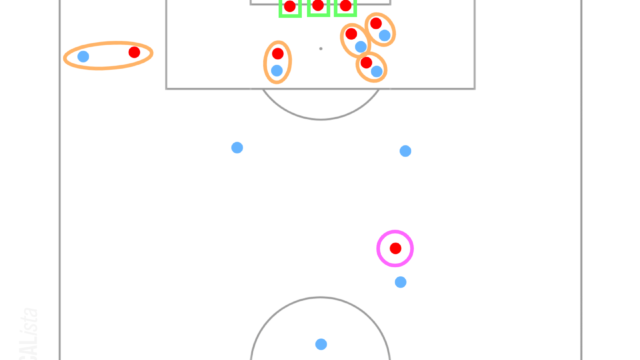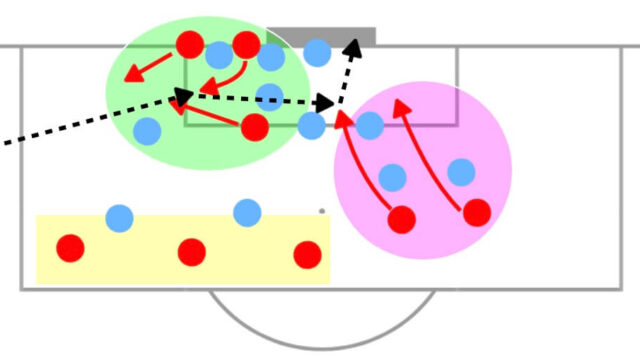Newcastle United Attacking Set Pieces Analysis 23-24 [Variation of Short Corners]
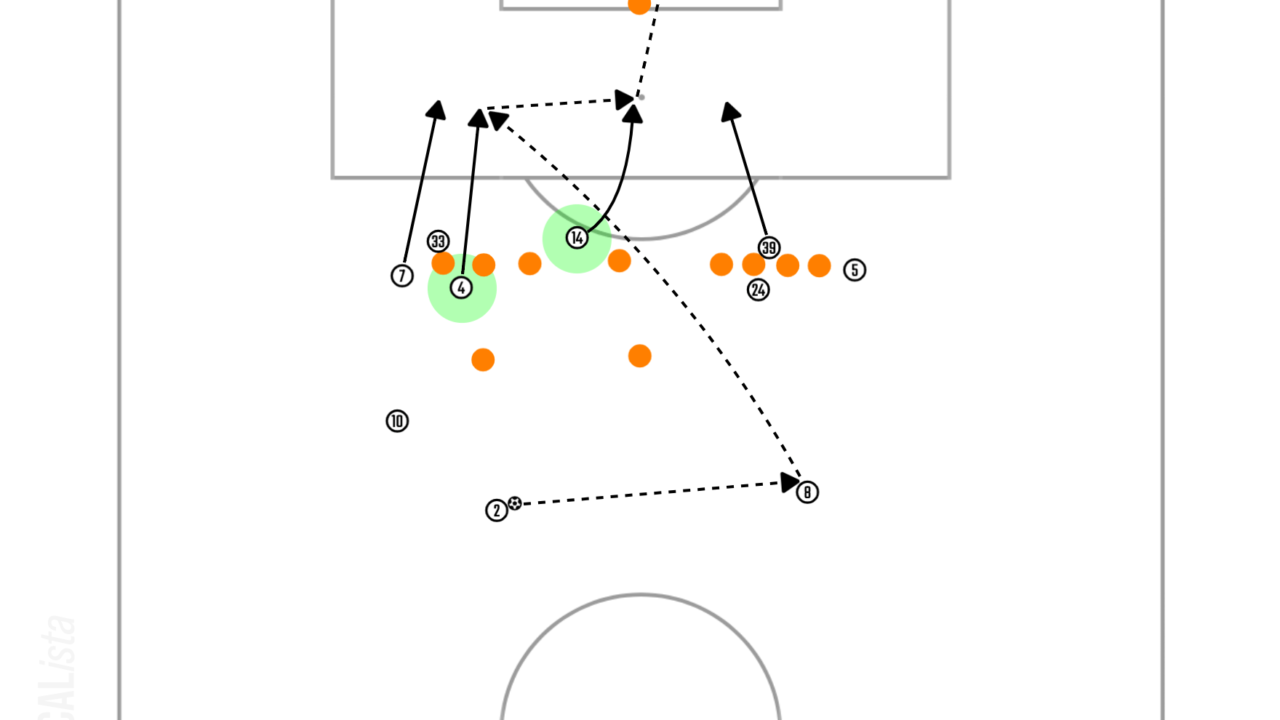
Overview
In this article, the tactics of attacking set pieces of Newcastle under Eddie Howe are going to be analysed. Almost in every game, they have played well-designed short corner kicks or trick plays, and the variety of routines is so interesting.
They have clear and simple strategy in both attacking corner kicks and free kicks, but thanks to many strong target players, they can be flexible in selecting the main targets for each routine. Additionally, they make the most of small players to create more chances. These small players have important tasks such as blocking the opponents or receiving a short corner to cause problems.
However, they have a weakness due to the designed routines. It requires a few extra players, which leaves the space in behind for the opposition to play a counterattack. This aspect is also going to be explained in detail. I hope you will enjoy this article.
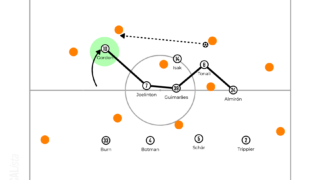
Attacking Corner Kicks
In this chapter, the tactics of attacking corner kicks are going to be analysed. Firstly, it is important to understand the characters of players.
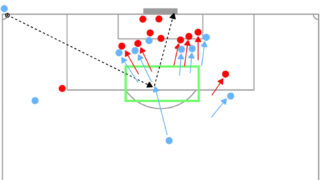
As it was mentioned, Kieran Trippier takes all set pieces and he can deliver accurate and various balls. He mainly curves the ball, but it can be also dropped quickly, which enables it to be delivered past the opposition goalkeeper towards the back post. The ball can also be delivered straight towards the far side, although this pattern is quite rare as he often delivers the ball towards the far side with both in- and out-swing.
Newcastle have numerous target players. It is not only about the height, but they have so many strong options, Dan Burn is 198cm, Sven Botman is 193cm, Fabian Schär is 185cm, Jamaal Lascelles is 188cm, Joelinton is 185cm. Alexander Isak is 193cm, but he is not a main target player in the box and focuses on putting the ball into the back of the net at the back post after the ball is flicked at the first post.
To categorise them, it is possible to divide them into two types, mobile attackers or static attackers. Of course, it is just a tendency and as many coaches try to disguise the opposition, they can suddenly perform different patterns. Burn and Schär are mobile attackers and Burn often makes a curved run to drift towards the back post. On the other hand, Botman, Lascelles and Joelinton are static attackers and they often just stand still to be found by Trippier or make a short and powerful run in front of the goal.
They often place six players in the box and it consists of three or four targets and two or three supporting players. These supporting players have some specific tasks such as blocking the opposition zonal defender, receiving a short corner and most importantly, putting the ball into the back of the net after the ball is flicked at the first post or headed back at the back post. In addition to these tasks, Miguel Almirón is sometimes assigned the task to take a first time shot in the box after a specific routine or Elliot Anderson can be a target by popping up at the first post or even diving towards the back post from the outside box.
Then, the setups and patterns as a team are going to be analysed. The basic setup is a taker on the ball, six players in the box, two players around the D and a player at the back.
Firstly, the setups and routines against the opposition who marks most targets in the box are going to be explained. These types of oppositions can be described as man marking or mix marking, but the most important thing is they are marking the target players. In this situation, three or four target players often position themselves closer to each other and make a split runs towards each destination.

Against man marking setups, they often target at the space at the first post. This is because there are only a few zonal defenders around there, so the space can be exploitable. This pattern is often executed when the out-swing delivery comes from the right side and targets the first post area.
In contrast, when the opposition defends with a zonal block on the six-yard line, the ball is often delivered towards the middle area.

Due to the lack of the space at the first post, they aim to attack the middle area and compete against the opposition defenders in the air. The out-swing delivery which curves away from the goal, so there is an advantage for the attackers who run towards the goal.
On the other hand, when the corner is taken from the left side with the in-swing, there are some variations and they can be executed against both man marking and zonal defending. Unlike the pattern above, the target players spread in the box and positioned themselves individually. Then, the ball is delivered towards the back post area.

It is often Burn who drifts towards the back post area with sometimes using a screen to lose his marker. His powerful run itself is strong enough to win the duel against his marker and also his mobility is crucial in this pattern. Additionally, one or two supporting attackers block the opposition goalkeeper to let the ball goes past him.
Similarly, they aim to find an attacker at the back post against zonal or mix setups.

Usually, against zonal or mix setups, it is possible to create an unmarked player in front of the opposition zonal block. Therefore, he can attack the back post area without being marked, so this can be an advantage. In case some opponents mark the target players, they combine the methods of attacking against the man marking and zonal defending, so they try to let the target attacker be free by using a screen from the close positions.
Another tactic of the in-swing delivery is gathering all attackers in the six-yard box.

The delivery area varies, so the ball can be delivered towards the front post or back post. Since they have so many tall players and the taker who can deliver a fast ball, it makes sense that this setup can be executed against all types of oppositions.
One of their strengths is the rich variations of short corners. the well-designed short corner is often executed the first corner kick of the game, or sometimes both the first in-swing and out-swing corner of the game.
The most frequent routine is finding a player who runs from the inside of the goal to play a short corner.

The first movement from the blind sides of the zonal defenders at the first post will delay their reaction, which enables the player to receive the short corner away from the pressure and also it is beneficial to avoid being an offside when the taker receives the ball back.
The cross after a short corner is often delivered towards the back post. There are usually target players at the back post, but sometimes the seventh attacker runs towards the back post from outside the box.

This can create a confusion in the box, but if they fail it, there is a risk of being exploited the space behind. Usually, there are two players at the edge of the box plus an extra player around the centre circle. However, if the seventh attacker goes higher, there are only two players left outside the box.

Against Aston Villa, the cross from Trippier was unsuccessful and the last defender was forced to step forwards, but the ball was intercepted and they conceded a counterattack which resulted in a shot. This was a clear mistake of the cross, but occasionally they have no players around the halfway line and the last line is at the edge of the opposition box when they put the seventh attacker in the box. This is a realistic risk because they have already failed the first routine of the short corner in three games, which the crosses were intercepted by the opposition.
Attacking Free Kicks
The strategy of attacking free kicks is so simple, which is blocking the opposition middle defenders and create gaps to penetrate. There are mainly two supporting attackers in the middle, who are Bruno Guimarães and another midfielder such as Anderson or Sandro Tonali.

In terms of the deliveries, Trippier aims at the first post from wide areas, but it can be the middle area against the opposition zonal defending. On the other hand, when delivering the ball away from the opposition goal and the opposition back line is not in the box, the delivery can be towards the back post area thanks to the huge space in behind.
Newcastle can make it a proper set piece even if a free kick is awarded in the midfield. They play a long free kick and they have already scored some goals from a long free kick.
In long free kicks, they hardly deliver the ball directly into the box. Trippier plays a horizontal pass to create an angle and then the ball is delivered diagonally.

The horizontal pass will force the opposition defenders to change the body angles and make it difficult for them to drop back and keep the eyes on the outside attackers. In addition to this, they use a screen in the furthest area to let the outside attacker be free. This pattern can be executed in the middle area of the final third to overcome the lack of the angle.
Like the corner kicks, the target players change each role flexibly thanks to the number of target players. Therefore, for example, mainly Burn becomes the target player at the furthest area, but he can also set a screen to help another teammate. In the middle, Isak is always there and his job is just scoring a goal.
Conclusion
Overall, their strategy is so simple, but there is flexibility in individual roles thanks to the rich number of target players in the squad. Additionally, the designed routines can create goal scoring chances for the small players, which can increase the number of players who can be a threat in set pieces.
However, there is a clear weakness after failing to play a designed routine, and they have already made some mistakes which led the opposition counterattacks. So far, it is quite predictable what they will do for a short corner, so there is room for improvement in this area. Thank you for reading. I hope you enjoyed this article.
